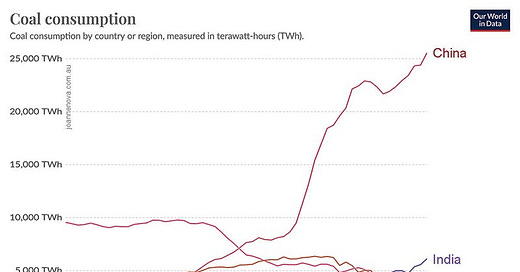China’s Coal Paradox: Driving Renewables Abroad While Burning Coal at Home
Investigating the Discrepancy Between China’s Renewable Energy Rhetoric and its Ongoing Coal Consumption and GHG Emissions.
China's reliance on coal has been a cornerstone of its rapid economic growth over the past few decades. This dependency is evident in the significant rise in coal consumption, as shown in the figure from the Energy Institute's Statistical Review of World Energy (2024).
While China has ramped up its coal usage to support its industrial expansion, it has also played a strategic role in pushing other nations towards renewable energy sources. This dynamic has influenced global coal prices and energy policies, creating a complex landscape where China benefits from low coal prices while promoting green energy abroad.
As renewable energy sources like solar and wind have come online over the past decade, coal prices have experienced significant fluctuations. Initially, the increased adoption of renewables led to a decline in global coal demand, which in turn caused coal prices to drop. Countries and companies shifted investments towards cleaner energy, driven by both environmental policies and the decreasing costs of renewable technologies. However, despite this trend, recent years have seen a spike in coal prices. This surge can be attributed to several factors, including a rebound in industrial activity post-COVID-19, supply chain disruptions, and geopolitical tensions impacting coal supply.
China's coal consumption has surged dramatically since the early 2000s, with the country now consuming more coal than any other nation. The figure above highlights this exponential growth, particularly since the early 2000s, when China's coal consumption rose from around 5,000 TWh to over 25,000 TWh by 2023. This increase aligns with China's industrial boom, urbanization, and overall economic development. The primary reasons for this reliance include economic growth, energy security, and industrial needs. Coal remains a cheap and abundant energy source that has fueled China's manufacturing sector, a critical driver of its economy. Additionally, China has vast domestic coal reserves, reducing its reliance on foreign energy imports and enhancing its energy security. Heavy industries such as steel, cement, and power generation are heavily dependent on coal.

While China continues to expand its coal consumption, it has also strategically supported the global shift towards renewable energy. This support has had several implications. By investing in renewable energy technologies and promoting their adoption worldwide, China has helped drive down the costs of renewable energy through economies of scale, making solar and wind energy more competitive with fossil fuels. As other countries reduce their coal consumption in favor of renewables, global demand for coal has decreased, leading to lower prices. This benefits China, which continues to rely on coal as a primary energy source. Furthermore, China's investments in renewable energy projects abroad enhance its global influence and create new markets for its green technologies.

China's dual approach of increasing domestic coal consumption while promoting renewable energy internationally can be seen as a strategic maneuver.
Keep reading with a 7-day free trial
Subscribe to Irrational Fear to keep reading this post and get 7 days of free access to the full post archives.





